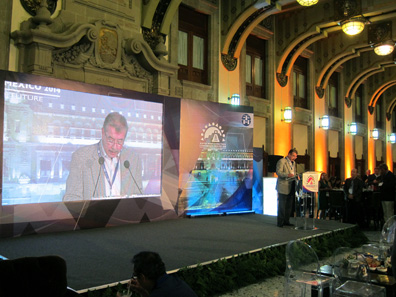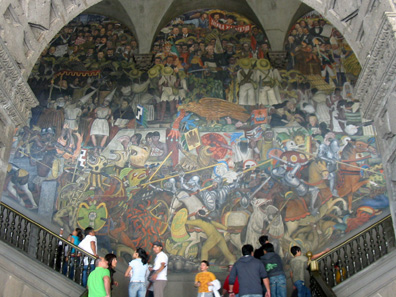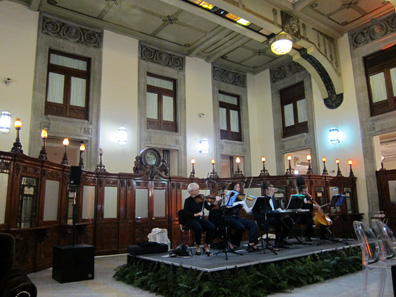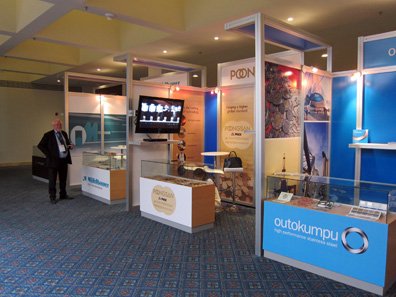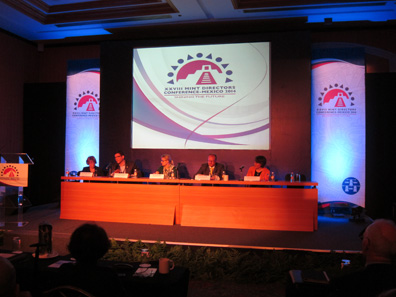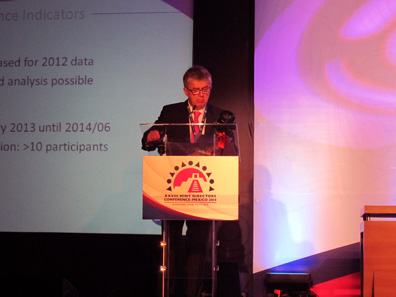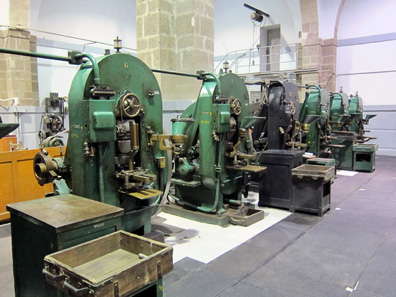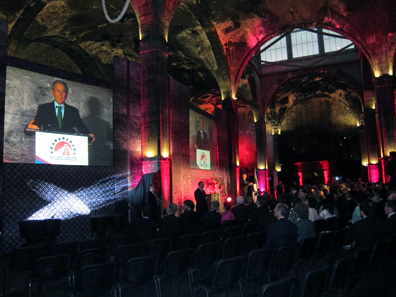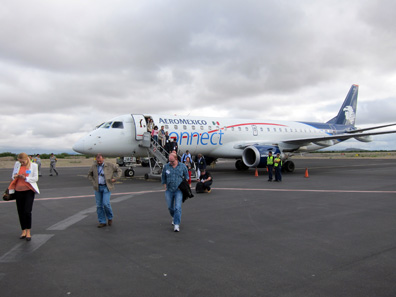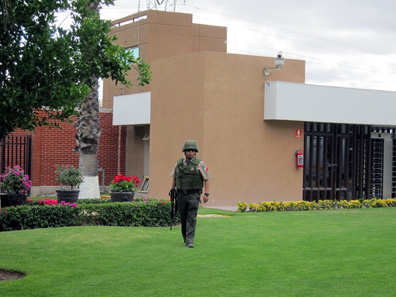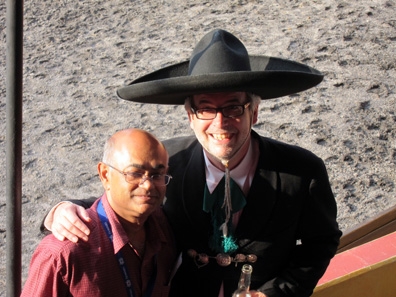by Ursula Kampmann
June 5, 2014 – Between 11 and 14 May 2014, the 28th Mint Directors Conference took place in Mexico. Mint representatives from approximately 40 nations discussed current issues relevant to coin manufacturers.
Guillermo Hopkins Gámez, CEO of Casa de Moneda de México. Photograph: UK.
“Mi casa es tu casa.”, translates in English as “My home is your home.”, as the Mexicans welcome their guests. At the heart of this saying is the incredible hospitality a stranger enjoys when coming to Mexico. This hospitality experienced the attendants of the 28th MDC, conducted by Casa de Moneda in Mexico City, first-hand. “Mi casa es tu casa.” – with these words Guillermo Hopkins Gámez, who had taken over as CEO of Casa de Moneda de México only a couple of weeks before, welcomed his guests.
One of the monumental socio-critical wall paintings at Palacio Nacional, painted by Diego Rivera. When we visited the site it had already become much too dark to take a picture of it. Photograph: Wikipedia / Thelmadatter.
The invitation for a welcome cocktail on day one had come from the Ministry of Finance, and the location was the gorgeous Palacio Nacional, formerly the residency of the Vice-King of New Spain and, since the 19th century, the seat of government. In 1926, it had been redecorated by Diego de Riviera with his socio-critical murals and is a must-have-seen of every city tour.
Musical entertainment in the evening. Photograph: UK.
A beautiful, old ticket hall supplied the background for the first official meeting of the conference participants. Here they tasted the first mescal and the first tequila to the effect that the acoustic level rose a bit. It was something like a family get-together. Everybody greeted friends he had not seen in a long time. After all, the ones involved in the production of coins are so few in number that all are well-acquainted. That promoted cooperation and made everyone be in a good mood in no time.
Former MDC President, Gerhard Starsich, CEO of Austrian Mint, welcomes the congress participants. He ceded his office in Mexico to Guillermo Hopkins Gámez. Photograph: UK.
You must not assume, on the other hand, that a congress is accompanied by too much revelry. Quite the contrary, the schedule’s main characteristic was that is seemed to neglect the fact that human beings need a little bit of sleep from time to time in order to give their attention to the challenging papers and discussions.
View inside the exhibition floor. Photograph: UK.
On Monday morning, 8 a.m. sharp, Prof. Stephane Garelli from Université de Lausanne actually made his listeners roar with laughter – and reflect on the other hand – with his opening lecture on the current economic situation. He summarized the present economic development as follows: the world is changing. The focus areas of innovations are shifting; to China, at present, presumably to Africa soon. The economy of the Western world is totally uninformed about what is actually going on there. Instead of facing up to the Chinese market, it tries to persuade the people in the West, who already have everything they need, that they are in desperate need of something else. Although business concerns like Apple have hitherto managed to do just that with quite an amount of success, the economic environment is going to get more and more rough, as long as the concerns do not convert their products and hence make them become interesting for those social strata which are expected to witness the largest earnings growth in the next years: for all those people with a daily income of up to 10 $.
Professor Garelli with his witty remarks butchered entire flocks of sacred cows, as it were. Like, for example, the common belief that there is no such thing as a youth too educated. On the contrary, according to Garelli, unemployment of young people is largely due to the fact that we have far too many academics and no one left anymore to do the simple jobs.
The podium of the first marketing session. Photograph: UK.
And so the congress participants were in high spirits when they turned towards their actual topics, after Mr. Sarun Thamrongrat had said out loud what everybody was thinking: “Anyone succeeding Mr. Garelli will have a hard time.”
Which, by the way, did not come true since the speakers – who were invited by the head of marketing committee, Kirsten Petersen, for marketing and assembled by the head of technical committee, Prabir De, for the technical department – possessed too much professional expertise. Marketing’s key subject was addressed by papers revolving around the problem of how to enhance customer relations with the different possibilities offered by the social media on the internet. Royal Canadian Mint and Monnaie de Paris waxed lyrical about their sales being boosted thanks to making use of Facebook and Twitter. What was not mentioned, however, was the fact that sales in the traditional coin trade, too, were boosted since 2008 without using the means of advertising and social media on a large scale. The experts unanimously agreed that the growth will continue – at least for the time being. As many collectors advanced in age may recall, that was exactly what the experts thought in the early 1980s, just before the coin prices nosedived.
Who really has to worry, at least when listening to the ideas of international marketing departments, is the local coin dealer specialized in modern coins. His share in the business is something the mints – with only a very few exceptions – would only be too pleased to enter into their books. And nobody seems to reflect upon the fact that the local coin dealer is an important little animal in the biotope of coin collecting who makes sure that acquired coins can be sold again. The question is if customer-to-customer sale platforms like eBay are really suited to take over the function of a coin trader when the local coin dealer has disappeared for good. By the way, the coin magazines, funded by advertising revenues for the most part, likewise are on the Red List of endangered species. You see, the basic idea behind the new advertising policy is that the money needed to maintain the social media is exactly the money you otherwise would have to spend on conventional advertising.
Coin dealers and coin magazines have one thing in common: they are a switching point where the customer can get direct and unbiased information about what is currently going on at the coin market. Once they have vanished, the world as the collector knew it comes to an end.
A view inside the floor where the participants of the Packaging Competition were exhibiting. Photograph: UK.
That is probably of minor importance to the mints which do not so much address the traditional collector. Coins and medals are becoming something of a lifestyle product that comes in elaborate packages and is offered as souvenir and gadget to any kind of buyer. The goal is to find new target groups, and the Royal Canadian Mint in particular fosters great ambitions as to how many households it wants to win as customer of its products.
This is likewise the backdrop of the widely recognized competition for the most beautiful packaging that was arranged on the occasion of MDC, in which Monnaie de Paris turned out this year’s winner in many categories. It was a pity that sale was at the heart of everything with MDC without keeping in mind that every coin inherently promises to be of stable value. Customers, old and new ones alike, are buying at the moment. What happens when they want to sell again only to find out that they gain only a tiny fraction of the money they have invested? Will it be something similar as in the 1980s when people realized with bitterness that medals only have metal value, glittering as their packaging might be? The (wrong) assumption that every medal is nothing but a case of fraud still wanders like a ghost in the collector forums.
Peter Huber is the chair of the morning session of the technical committee on Tuesday. Photograph: UK.
In the technical section, two developments are noticeable: on the one hand, it is about reduction of costs, on the other it is about safety. The main question all technicians ask themselves can be summed up as: how to produce a coin as safely as possible for as little money as possible?
That was why this session addressed subjects like the optimal division between coin and banknote, new and affordable alloys, optimizing procedures – be it in regard to minting with the aid of computer simulation or to the polishing of blanks with the aid of mass screening –, colored coins for circulation and special inks to protect commemorative medals against counterfeit, the new Royal Mint security system and latent images. In addition to that, there was a session – for mint officials only – on recent cases of counterfeiting.
A major accomplishment of MDC is the agreement on universal standards. Matti Rastas of the Mint of Finland gathered criteria that can be applied as guidelines for quality definition for coin blanks. And Peter Huber works on establishing a reliable benchmark as to what can be achieved in the minting industry.
The congress participants relax on the first evening of the congress in Palacio de Bellas Artes. Photograph: UK.
A new aspect of the discussion is the mint’s role as an employer; hence, how to motivate the personnel to think for themselves, take responsibility and better watch one’s health. It is about security, equality and visions for a shared future. It comes as no surprise that the last session of the day witnessed mainly market leaders as speakers. After all, companies that rely on a healthy and confident workforce can envisage higher turnovers and profits. Royal Australian Mint therefore reported about their program for improving the health and wellbeing of their staff. Great Britain’s Royal Mint introduced its programs for improving structural processes. The Mint of Finland elaborated on how they exercised their responsibility for employees, environment and commissioners. And the Austrian Mint presented a survey in which it had been evaluated as employer by its employees. There will be a more thorough summary of the single papers in another MintWorld article soon.
Minting room of the museum at Casa de Moneda. Photograph: UK.
The busy program notwithstanding there was some spare time left for evening events. Traditional highlight was the gala dinner held at a very special location, the Mint Museum of Caseade Moneda, a fully functioning mint with machinery as it had been state of the art around 1900. The mint museum, too, was something so special that we will give you an account of it in a separate article.
Foundry at Casa de Moneda’s museum. Photograph: UK.
The huge foundry of the former mint of Mexico with its ambient illumination was the location where the program of the gala evening took place and which also saw …
An unexpected guest, former President of the USA, George W. Bush. Photograph: UK.
… an unexpected guest.
An airplane transported some of the congress participants to the Mexican Mint at San Luis Potosí. Photograph: UK.
Some guests had a very short night indeed for the coaches left at 5:30 in the morning for the airport. While most of the congress participants stayed in the hotel to attend business meetings, about 100 overtired people set out to visit the Mexican Mint facilities at San Luis Potosí.
Mexican Mint. Unfortunately, it was strictly prohibited to take any pictures inside the mint. Photograph: UK.
Divided into a number of groups, they visited the production sheds. It was a highly interesting tour because Casa de Moneda is one of very few companies that can give you an understanding of virtually every single step involved in the production of a coin, from casting the coils of which the blanks are made, designing the subjects for a coin up to the production of dies, the coining and packaging.
Schuler Pressen GmbH invited for the good-bye evening. This is Dieter Merkle representing the company, wearing the traditional costume of the Mexican charros. Next to him is Prabir De, Head of the Technical Committee of MDC. Photograph: UK.
Those who had visited San Luis Potosí went straight from the airport to a genuine Mexican entertainment, a charrería, where they met the other congress participants. They all sat in a large arena and watched equestrian games that a European viewer might well take for American rodeo.
Another successful Mint Directors Conference has come to an end. The next MDC will be hosted by the Royal Thai Mint in Bangkok.
If you like to learn more about Casa de Moneda (and speak Spanish), click here.
An English history of Casa de Moneda is given by CoinsWeekly.
Here you can find more information about the Mint Directors Conference.
If you like to listen to a smashing paper by Professor Stephane Garelli youself, click here and you will be redirected to his webite. We recommend “From Breakdown to Breakthrough – Part 2”.
A charrería can be watched here.



